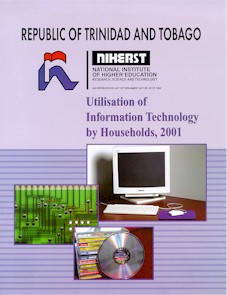
In this publication, the National Institute of Higher Education, Research, Science and Technology (NIHERST) presents the results of the first Survey on the Utilisation of Information Technology by Households in the Republic of Trinidad and Tobago.
The survey was designed to provide empirical data on the penetration of Information Technology in private households and has generated essential benchmark indicators for comparison with future longitudinal studies of similar objectives.
Summary of Main Findings
Data Highlights
- Only 13.0% of the households in Trinidad and Tobago (approximately 44,600 households based on national statistics for 2000) had a home computer as at June 2001; 26.9% in Diego Martin, 19.8% in San Fernando and 18.8% in Chaguanas.
- For purposes of comparison, more than 30% of the households in a number of Organisation for Economic Co-operation and Development (OECD) countries were equipped with computers by 1997, and more than half (54.0%) of the households in Australia had computers in May 2000.
- Affordability was the major constraint in 56.0% of all households without computers, ranging from 43.9% in the City of Port of Spain to 78.0% in the Borough of Point Fortin.
- 53.0% of households purchased computers from private savings; 13.0% accessed Government loans.
- Households (20.0%) with gross monthly incomes of $6,000 - $7,999 had the largest proportion of home computers, followed by 15.0% of households with incomes of $4,000 - $5,999. Only 5.0% of households with monthly incomes of less than $2,000 had computers.
- In 2000, 27.0% of the computers were acquired compared with 6.7% in 1997. Almost three out of four persons (73.0%) in each household used the computer .
- The proportion of male (51.0%) to female (49.0%) computer users was generally similar .
- 16.6% of computer users were between 15 - 19 years, 16.3% between 30 - 39 and 14.5% between 40 - 49.
- Of computer users, 50.0% had acquired secondary level education; only 3.8% had a university level education in computer studies.
- 50.0% of computer users were employed and self-employed and 39.0% were students.
- In Private Enterprises, 59.8% of employees used the computer compared with 29.7% in Government.
- Windows 98 and 95 were the main operating systems in 74.4% of households.
- Most households (70.8%) used the computer daily between two and five or more hours.
- Only 11.8% of households were engaged in software development and 20.2% accessed distance learning/education compared with other activities such as games (78.4%), Microsoft Office (66.0%), e-mail (62.4%) and web searches (61.5%).
- By value of e-commerce transactions, 42.2% of the households spent less than $500, while 35.6% spent between $500 and $2,999 over the six month period ending May/June, 2001.
- A significant proportion of households (40.0%) was dissatisfied with the service of Internet Access Providers due to 'high cost', 'too much time for connection' and 'interruption while working'.
- Of the households with Internet access, 19.5% reported e-commerce transactions, mainly in the purchase of computer hardware/software, electronic goods and books and magazines.






